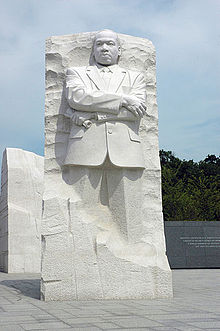Wednesday January 18 –
The signs that divide us – both literal and metaphorical – have often targeted people of color. This was especially true during the era of segregation. Wherever one went, particularly in the South, placards reading “for White only” or “for Colored only” identified racially-segregated spaces. In the following segment from her autobiography Brown Shoes (1956), Pauli Murray recounts the pervasiveness of these signs and their effects on African Americans. She also points to the influence of less overt “signs” of the color line. Murray (1910-1985) spent much of her life fighting against the race and gender divide – as a civil rights lawyer, college professor and administrator, deputy attorney general of California, and a founder of the National Organization for Women. Late in life, she was ordained as an Episcopal priest.
What “signs” target people of color today?
Roy E. Finkenbine and the Martin Luther King Week/Black History Month Planning Team
Today’s post: Pauli Murray, Excerpt from Brown Shoes
I saw . . . the signs which literally screamed at me from every side – on streetcars, over drinking fountains, on doorways: FOR WHITE ONLY, FOR COLORED ONLY, WHITE LADIES, COLORED WOMEN, WHITE, COLORED. If I missed the signs I had only to follow my nose to the dirtiest, smelliest, most neglected accommodations or they were pointed out to me by a heavily-armed, invariably mountainous red-faced policeman who to me seemed more a signal of calamity than of protection. I saw the names of telephone subscribers conspicuously starred “(C)” in the telephone directory and the equally conspicuous space given to the crimes of Negroes by the newspapers, the inconspicuous space given to public recognition and always with the ignominious and insulting “negro” and “negress.”
Each morning I passed white children as poor as I going in the opposite direction on their way to school. We never had fights; I don’t recall their ever having called me a single insulting name. It was worse than that. They passed me as if I weren’t there! They looked through me and beyond me with unseeing eyes. Their school was a beautiful red-and-white brick building on a wide paved street. Its lawn was large and green and watered every day and flower beds were everywhere. Their playground, a wonderland of iron swings, sand slides, seesaws, crossbars and a basketball court, was barred from us by a strong eight-foot-high fence topped by barbed wire. We could only press our noses against the wire and watch them playing on the other side.
I went to West End [School] . . . on Ferrell Street, a dirt road which began at a lumberyard and ended in a dump. On one side of this road were long low warehouses where huge barrels of tobacco shavings and tobacco dust were stored. All day long our nostrils sucked in the brown silt like fine snuff in the air. West End looked more like a warehouse than a school. It was a dilapidated, rickety two-story wooden building which creaked and swayed in the wind as if it might collapse. Outside it was scarred with peeling paint from many winters of rain and snow. Inside the floors were bare and splintery, the plumbing was leaky, the drinking fountains broken and the toilets in the basement smelly and constantly out of order. We’d have to wade through pools of foul water to get to them. At recess we herded into a yard of cracked clay, barren of tree or bush, and played what games we could improvise like hopscotch or springboard, which we contrived by pulling rotten palings off the wooden fence and placing them on brickbats.
It was never the hardship which hurt so much as the constant contrast between what we had and what the white children had. We had the greasy, torn, dog-eared books; they got the new ones. They had field day in the city park; we had it on a furrowed, stubbly hillside.
They got wide mention in the newspaper; we got a paragraph at the bottom. The entire city officialdom from the mayor downward turned out to review their pageantry; we got a solitary official.
Our seedy run-down school told us that if we had any place at all in the scheme of things it was a separate place, marked off, proscribed and unwanted by the white people. We were bottled up and labeled and set aside – sent to the Jim Crow car, the back of the bus, the side door of the theater, the side window of a restaurant. We came to know that whatever we had was always inferior. We came to understand that no matter how neat and clean, how law abiding, submissive and polite, how studious in school, how church-going and moral, how scrupulous in paying our bills and taxes we were, it made no essential difference in our place.
It seemed that there were only two kinds of people in the world – They and We – White and Colored. The world revolved on color . . .
The MLK Week and Black History Month Planning Team:
Roy Finkenbine, Ph.D., Professor of History and Director of the Black Abolitionist Archive
Lanae Gill, Director, Residence Life
Fr. J. Timothy Hipskind, SJ, Director of Service-Learning, Institute for Leadership and Service
Adam Hollmann, Assistant Director, Student Life Programming
Anita Klueg, Director, University Ministry
Drew Peters, Assistant Director, Student Life Office
Dorothy Stewart, Associate Dean of Students
Monica Williams, Dean of Students
Alex Zamalin, Ph.D., Director of African American Studies
Invited Guests: Jillian Stewart, Campus Kitchens Manager; Rafael Cruz-Serrano, Professional Mentor I, King-Chavez-Parks (KCP); and Janice Strickland, Professional Mentor II, King-Chavez-Parks (KCP)

